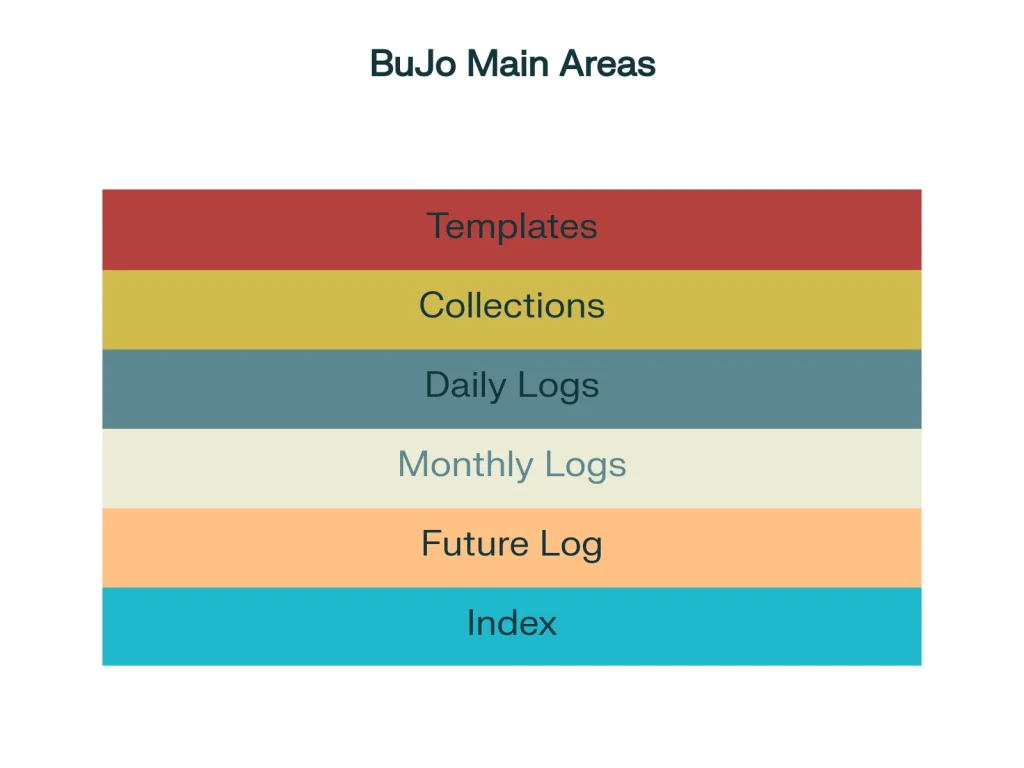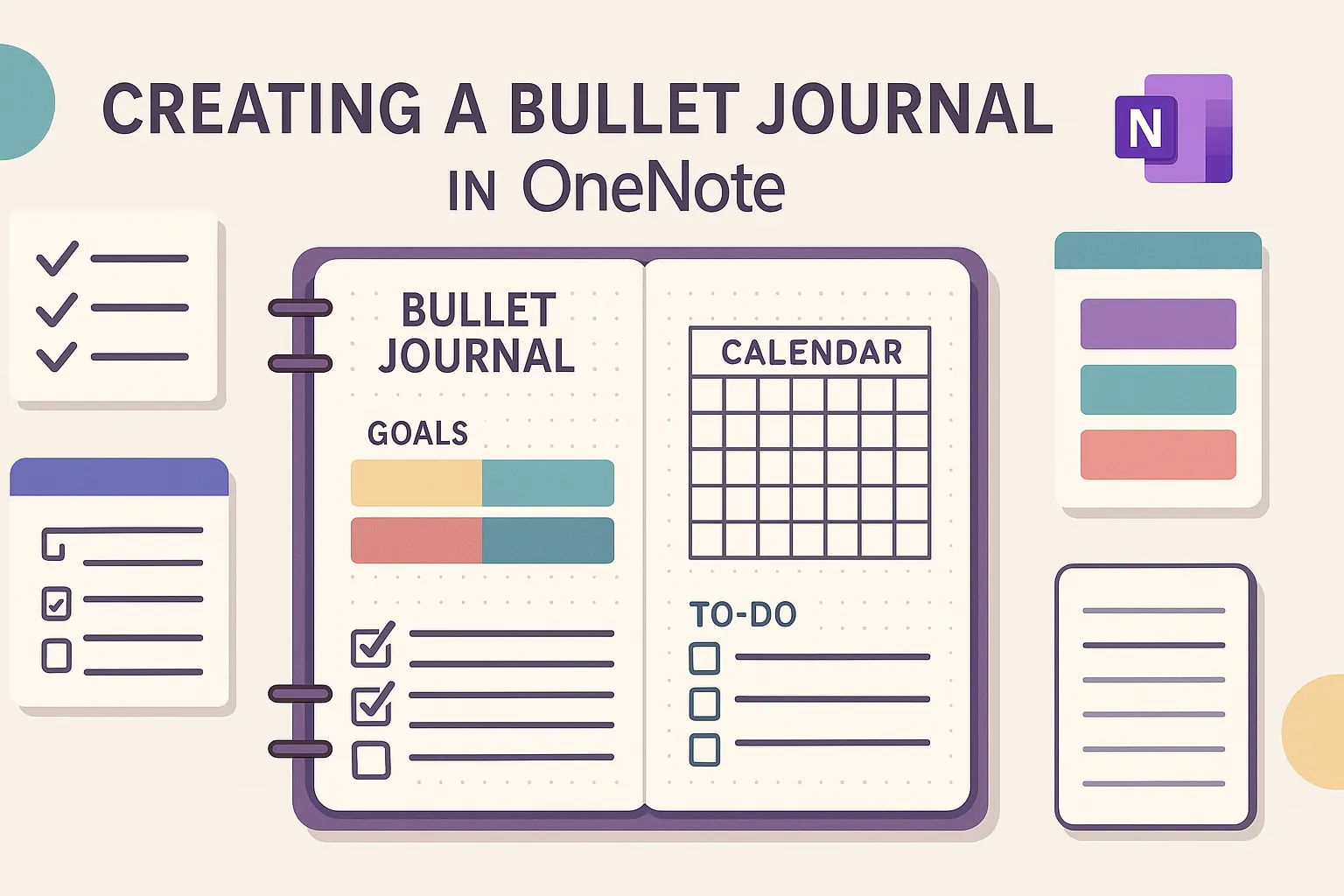Bullet journaling is a powerful way to stay organized, but carrying around a notebook isn’t for everyone.
If you already live in the digital world, why not move your bullet journal there too? Microsoft OneNote is one of the best digital tools for this. It’s free, flexible, and works across all your devices.
Below, you’ll learn how to create a bullet journal in OneNote that’s practical, clean, and personalized. No fluff—just the real steps, tips, and layouts you need to make it work.
What you’ll learn from this blog:
What Is a Bullet Journal, Really?
At its core, a bullet journal (BuJo) is a simple system created by Ryder Carroll for organizing tasks, events, and notes using bullet points.
The power is in its flexibility—you design the system that works for you. On paper, this often includes:
- Index: A table of contents (how to make a bullet journal index)
- Future Log: An overview of upcoming months (how to bullet journal for month)
- Monthly Log: Calendar + task list for the month (how to draw a calendar in a bullet journal)
- Daily Log: Rapid logging of tasks, notes, and events (how to write a bullet journal)
- Collections: Lists or notes grouped by topic (e.g., books to read, habit trackers, goals, tv show tracker bullet journal)
OneNote makes it easy to recreate and even upgrade this system, letting you make your own bullet journal or even make a digital bullet journal.
Why Use OneNote for Bullet Journaling?
Here’s why OneNote works so well for bullet journaling:
- Sections & Pages: These map perfectly to bullet journal components (how to layout bullet journal)
- Cloud Sync: Your notes sync across phone, laptop, tablet (how to make a bullet journal on phone, how to make bullet journals on android)
- Searchability: Find any task, note, or page instantly (how to use bullet journal app)
- Media Support: Drop in images, PDFs, voice notes, or drawings (how to decorate bullet journal, bullet journal doodles how to)
- Templates: Save time by reusing layouts (how to use bullet journal printables)
You can even combine bullet planner with personal journal or use bullet journal for work and project management.
Step-by-Step: Set Up a Bullet Journal in OneNote
1. Create a New Notebook Just for Bullet Journaling
- Go to File > New (desktop) or Notebooks > +Notebook (mobile).
- Name it something obvious like “Bullet Journal” or “BuJo 2025.”
- This keeps your bullet journal separate and easy to access (how to start a bullet journal for beginners).
2. Set Up Core Sections
Use sections for your main BuJo areas (how to layout bullet journal):
- Index
- Future Log
- Monthly Logs
- Daily Logs
- Collections
- Templates

Color-code them for faster visual reference (how to decorate your bullet journal cover, how to decorate first page of project bullet journal).
3. Build the Index Section
- Create a main page called “Index,” and hyperlink to other pages (how to make a bullet journal index).
- To add a link: Right-click a page > Copy Link to Page, then paste into the Index page.
4. Create a Future Log
- Set up a page with a grid of the next 6–12 months (how to bullet journal for month).
- Use tables or just text. If you’re on a tablet, sketch out your months with the drawing tool (how to draw a calendar in a bullet journal).
5. Set Up Your Monthly Log
- Each month, create a new page under “Monthly Logs.”
- Include a calendar or date list, a task list, and a goals list (how to start a simple bullet journal, how to start a minimalist bullet journal).
- Use OneNote checkboxes for tasks (how to use bullet journal effectively).
6. Daily Logs: Your Workhorse
- Log tasks, notes, and events each day (how to write a bullet journal, how to maintain a bullet journal).
- Use symbols for tasks, events, notes, completed, migrated, and cancelled items.
- Use OneNote’s checkbox tag for easy task tracking (how to use bullet journal app).
7. Collections: Track What Matters
- Create themed pages for habits, ideas, logs, etc. (how to do a habit tractor in a bullet journal, how to make a mood tracker bullet journal, how to set up a bullet journal for school, how to use a bullet journal for weight loss).
- Example: Habit Tracker, Reading List, Meal Plans, Goals Tracker.
- Build tables manually or copy from Excel into OneNote (how to make a bullet journal on lined paper).
8. Create Reusable Templates
- Once you’ve got a layout you like, duplicate it as a template (how to use bullet journal printables).
- Right-click the page > Copy, then paste into the “Templates” section.
- Duplicate each new month or day as needed.
Pro Tips to Keep It Sharp
- Search is king: Use keywords and tags so you can find anything later (how to use bullet journal effectively).
- Use mobile for quick logs: Capture tasks, thoughts, or photos on the fly (how to make bullet journals on android).
- Try voice memos or sketches: Especially useful if you’re on the go or using a tablet (how to draw bullet journal headers, how to draw banners for bullet journal).
- Review weekly: Set a time each week to migrate tasks, update logs, and tweak your system (how to keep yourself motivated to follow bullet journal).
- Don’t over-decorate: You don’t need stickers, colors, or washi tape to be productive (how to use washi tape in bullet journal). Unless that helps you—then go nuts.
Customizing and Decorating Your Bullet Journal
- How to write bullet journal calligraphy: Try different fonts or use a stylus for digital calligraphy.
- How to decorate bullet journal: Add color, stickers, or images.
- Bullet journal doodles how to: Use OneNote’s drawing tool for simple doodles.
- How to decorate your bullet journal cover: Add a custom image or drawing to your notebook’s first page.
- How to draw banners for bullet journal: Use the drawing tool to create banners for headers.
- How to improve your handwriting bullet journalbullet journal: Practice with the stylus or use neat digital fonts.
- How to write neat in a bullet journal: Stick to a consistent font or handwriting style.
- How to write quotes in a bullet journal: Create a collection page for favorite quotes.
Advanced Tips
- How to make a key for a bullet journal: Create a page listing your symbols and their meanings.
- How to bullet journal in a planner: Use OneNote alongside your digital planner.
- How to bullet journal when you’re not artistic: Stick to simple layouts—function over form.
- How to combine bullet planner with personal journal: Add a “Journal” section for reflections or meeting notes (how to take meeting notes in bullet journal).
- How to use bullet journal for project management: Create project-specific collections.
- How to use Trello as a bullet journal: If you want more structure, try Trello for digital bullet journaling (how to create a digital bullet journal with Evernote and compare).
- How to make a bullet journal in Keynote: If you prefer presentations, design your layouts in Keynote and import them.
- How to start a bullet journal to achieve goals: Dedicate a section to goal-setting and tracking.
- How to put your ideas in bullet journal: Use collections for brainstorming and idea capture.
- How to add pages to bullet journal: In OneNote, just click “Add Page.”
- How to make a bullet journal on phone: Download the OneNote app and sync your notebook.
Also Read:
The Story Behind the Bullet Journal: A Journey of Curiosity and Creativity
Final Thoughts: Is a Digital BuJo Right for You?
OneNote doesn’t perfectly replicate every aspect of a paper bullet journal—but it makes up for it with power, speed, and accessibility.
You won’t run out of pages. You won’t forget your notebook at home. And you’ll always be able to search and reorganize without rewriting anything.
If you’re already using OneNote for school, work, or personal notes, adding your bullet journal is seamless. And if you’ve been curious about how to start a bullet journal for beginners but hesitant about all the setup? OneNote makes it easier than ever to jump in.
Ready to try it? Start small: create your notebook, set up your Index, and log today’s tasks. You’ll be surprised how fast it becomes second nature.
Let me know if you’d like a companion template to go with this post—I can build out a downloadable version or give you layout ideas tailored to your needs!

